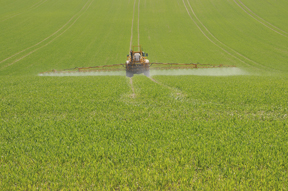 In September Pesticide Action Network North America and the National Resources Defense Council sued the Environmental Protection Agency to ban chlorpyrifos, an insecticide that is used on a variety of food and feed crops and golf courses. On its website, the EPA outlined that chlorpyrifos is used to:
In September Pesticide Action Network North America and the National Resources Defense Council sued the Environmental Protection Agency to ban chlorpyrifos, an insecticide that is used on a variety of food and feed crops and golf courses. On its website, the EPA outlined that chlorpyrifos is used to:
-
Control foliage and soil-borne insect pests on a variety of food and feed crops, and
-
Approximately 10 million pounds are applied annually in agricultural settings. The largest agricultural market is corn (~5.5 million).
The EPA also listed the impact on humans that are exposed to the insecticide:
“Chlorpyrifos can cause cholinesterase inhibition in humans; that is, it can overstimulate the nervous system causing nausea, dizziness, confusion, and at very high exposures (e.g., accidents or major spills), respiratory paralysis and death.”
In 2000, the EPA banned all household use of the insecticide except for ant and roach bait. Seven years later, several groups, including PANNA and NRDC, asked the EPA to revoke all use of the pesticide. In a petition to the EPA in September 2007, the groups wrote,
“Chlorpyrifos belongs to a class of pesticides called organophosphates, which EPA has grouped together based on their common mechanism of toxicity. The devastating effects of this class of pesticides, originally designed as wartime nerve agents including sarin gas, are attributed to their inactivation of an enzyme called cholinesterase. This enzyme is responsible for the timely deactivation of the nerve signaling protein acetylcholine.
“Clinical symptoms of organophosphate poisoning can include: eye pupil contraction, increased salivation, nausea, dizziness, confusion, convulsions, involuntary urination and defecation, and, in extreme cases, death by suffocation resulting from loss of respiratory muscle control.”
The same groups are now suing the EPA to reconsider its ruling and completely ban the insecticide. Some states are already taking additional action to control its use. In California for example, regulators are preparing to announce new restrictions on the use of chlorpyrifos, pointing to recent cases of sickened farmers, as well as accumulating traces of the chemical in waterways and fish. They are also concerned that overuse is making insects immune to the pesticide. A Huntington Post article[i] referred to three specific cases in California where workers were exposed to the insecticide:
“In 2007, officials say 26 vineyard workers in Tulare County were exposed to chlorpyrifos being sprayed in a neighboring almond orchard. The firm that applied the pesticide was fined $28,600.
“In 2008, 13 field workers in Monterey County clearing rocks were exposed. Seven became ill, and the company that applied the pesticide was fined $3,120. And in 2009, six landfill workers in Kern County got sick from spraying at a nearby orange grove, resulting in a $12,000 fine, state officials said.”
PANNA and NRDA, “want the EPA to release its revised human health risk assessment on chlorpyrifos for public comment in December 2014, along with either a proposed revocation rule or a proposed denial of the petition.”[ii] To review the case filed by the environmental groups against the EPA, visit Panna.org.
For more information about Chlorpyrifos, visit the EPA’s online fact sheet.
Related Teledyne Tekmar Application Notes: Earlier this year, Teledyne Tekmar conducted a lab study to determine the level of pesticide residue in vegetables, particularly tomatoes and green beans using its AutoMate-Q40. The test employed the Quick-Easy-Cheap-Effective-Rugged-Safe (QuEChERS) extraction method that has been developed for the determination of pesticide residues in agricultural commodities. Quantification was based on matrix-matched calibration curves with the use of internal standard to ensure method accuracy, QC samples were evaluated at levels of 20.0, 40.0 and 80.0 ng/g to ensure precision and accuracy of the AutoMate-Q40.
Green beans and tomato samples were prepared following “AOAC Official Method 2007.01 Pesticide Residues in Foods by Acetonitrile Extraction and Partitioning with Magnesium Sulfate”.
Click below to download the entire Application Note.
